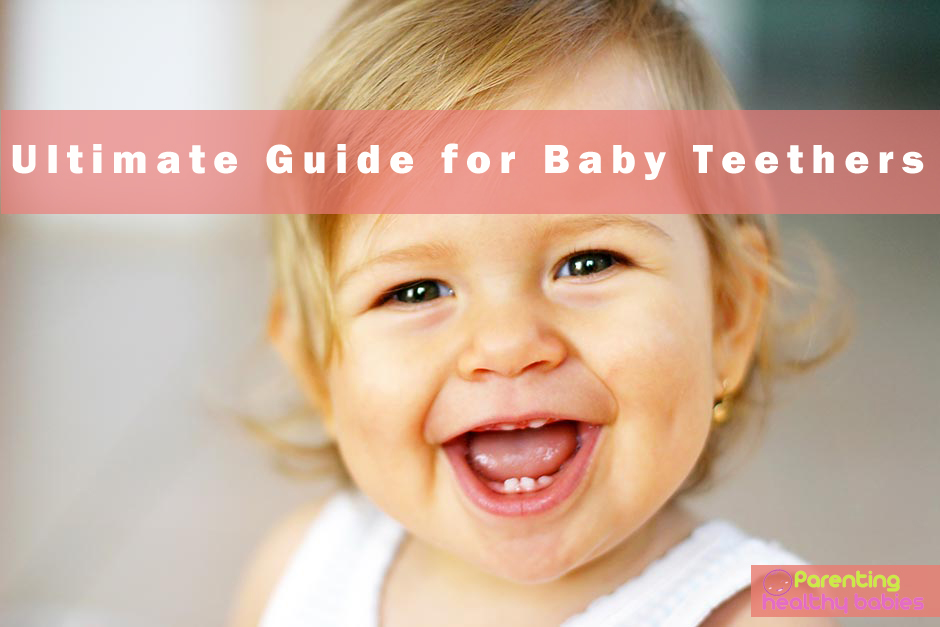The arrival of a baby means a lifetime of firsts. The first time your baby smiles, talks or walks, is going to be a moment you cherish forever. Another first milestone is the emergence of the first baby tooth in the mouth. This tiny little dental pearl is the first of a set of 20 baby teeth that will make their way into your baby’s mouth. By the age of 3 years, you should see a complete set of white sparkly ones in your child’s mouth.
An Ultimate Guide for Baby Teethers
What is teething?
The process of a tooth erupting into a baby’s mouth is called teething. The first tooth emerges at about 4 -6 months in a baby’s mouth. Teething is a normal physiologic process. However, many babies are uncomfortable during teething and you may see any or all of the following signs and symptoms of teething in your baby-
- Drooling of saliva
- Sore and red gums
- Irritability
- Increased crying
- Decreased feeding
- Disturbed sleep
Generally, fever and diarrhea do not occur because of teething alone, and other causes must be looked for these.
What are teethers?
During the teething process, a baby’s gums feel sore and uncomfortable. This makes a baby want to chew on something to relieve the soreness. Teethers are agents that allow a baby to chew on them, to alleviate irritation of the gums and provide relief.
How does a teether help relieve to relieve teething symptoms?
During teething, a baby’s gums may feel sore and inflamed. Chewing on a teether provides a pressure on aching gums and massages them. It also keeps a baby occupied as he/she chews on the teether toy. Always supervise your child to avoid inadvertent choking or swallowing of a teether or its parts.
How to choose a good teether?
Generally, it is best to choose a teether that has the following characteristics-
- A teether should be made of baby safe material, without harmful chemicals
- It should be sterilizable.
- It should not have small parts that represent a choking hazard.
What are the types of teethers available?
There are many types of teethers commercially available such as solid plastic, gel-filled, and water-filled. Any of these may be used to aid in the teething process. Teethers may be made of plastic, silicone, rubber or wood and have a variety of designs and shapes. Teethers come in attractive colors and shapes and you can choose from a wide range of animal or fruit shaped teethers. Wearable teether in the form of a necklace or bracelet that a mother can wear, are also available.
Chilled teethers
Some teethers, particularly fluid filled ones, can be chilled. A cool teether further aids in soothing tender gums. This is because they cause vasoconstriction or tightening of blood vessels of the gums and decreases inflammation. Teethers should be chilled in the refrigerator, not in the freezer.
Natural teethers
If you prefer natural remedies, you can try natural teethers. These are nothing but hard foods that a baby can chew. You can give your baby a cool and clean piece of carrot or cucumber to chew on instead of commercial teethers. Be careful to supervise your baby because small pieces of vegetable may be a choking hazard.
How can you keep a teether clean?
Since a baby repeatedly puts a teether into his/her mouth, it is important to keep it clean. If your baby is more than 6 months old, you can wash the teether with baby detergent and water thoroughly. If your baby is less than 6 months old, immunity might still be low, so it is better to sterilize a teether. This can be done through boiling it or placing it in a sterilizer. Read the instructions given on the teether packaging for correct sterilization instructions. Change your teether frequently if they show signs of fluid leaching or wear. Avoid sharing teethers between your and other babies because this can lead to transfer of germs.
A word of caution!
Latest studies have shown that the inclusion of harmful chemicals in teethers may be detrimental to the health of your baby. Toxic chemicals called parabens, phthalates and bisphenols are often present in plastic teethers that may leach out into your baby’s mouth. So look for paraben-, phthalate- and bisphenol- free products when selecting a teether for your baby.
A teether can help in comforting your baby at a time when his or her little baby teeth are emerging into the mouth. They help massage the gums and provide relief. However, choosing a good teether is important, especially one that is sterilizable and does not contain toxic chemicals.
Happy teething!
References
file:///C:/Users/Parveen%20Kumar/Desktop/Teething%20facts%20and%20%20fictions.pdf
https://www.ncbi.nlm.nih.gov/pubmed/27993041
